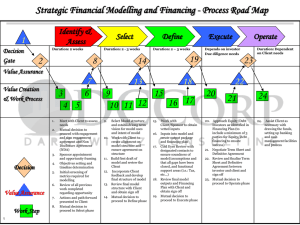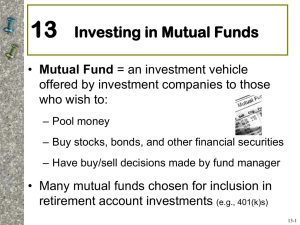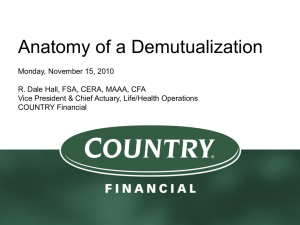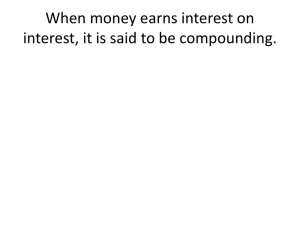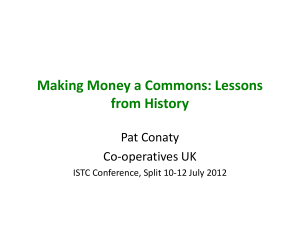Chapter 4
advertisement
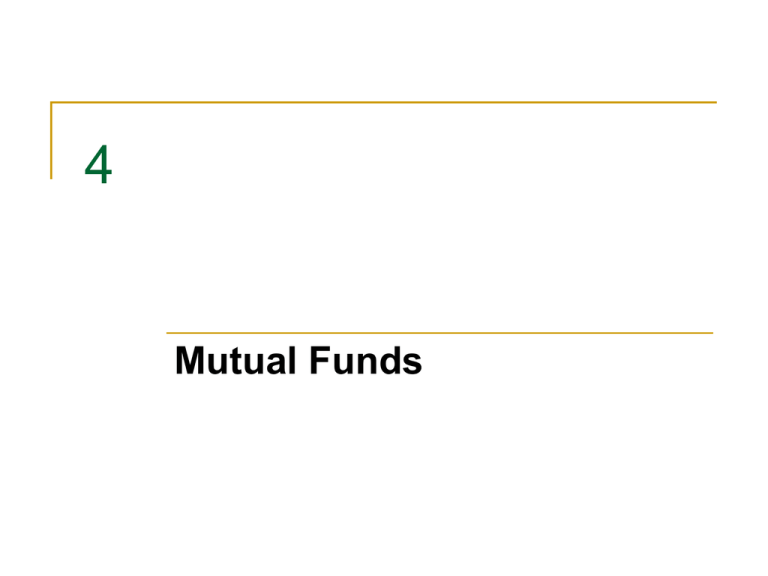
4 Mutual Funds Learning Objectives 1. The different types of mutual funds. 2. How mutual funds operate. 3. How to find information about how mutual funds have performed. 4. The workings of Exchange Traded Funds. 4-2 Mutual Funds: Overview • Around 1980, 5 million Americans owned mutual funds. • By 2007, 96 million Americans in 55 million households owned mutual funds. • In 2006 investors added $474 billion in net new funds to mutual funds. • In 2006, mutual fund assets totaled $10.4 trillion. 4-3 Mutual Funds: • A means of combining or pooling the funds of a large group of investors • Buy and sell decisions made by a fund manager, who is compensated for the service provided • A financial intermediary 4-4 Mutual Fund Basics • Advantages • Diversification • Professional management • Minimum investment • Drawbacks • Risk • Costs • Taxes • Distributions and profits 4-5 Investment Companies and Fund Types, I • Investment company = business that specializes in pooling funds from individual investors and making investments. • Open-end fund = an investment company that stands ready to buy and sell shares in itself to investors, at any time. • Closed-end fund = an investment company with a fixed number of shares that are bought and sold by investors, only in the open market. 4-6 Investment Companies and Fund Types, II Investment Companies Open-end Funds Money Market Funds Closed-end Funds Long-term Funds Stock Funds Bonds Funds Blended Funds 4-7 Investment Companies and Fund Types, III • Net asset value (NAV) is the value of the assets held by a mutual fund, divided by the number of shares. • Shares in an open-end fund are worth their NAV, because the fund stands ready to redeem their shares at any time. • In contrast, share value of closed-end funds may differ from their NAV. 4-8 Net Asset Value • Net asset value (NAV): • Assets under Management (AUM) = the value of the assets held by the fund NAV = AUM/Shares outstanding • Open-end fund share value = NAV • Closed-end fund share value may ≠ NAV. • ABC fund reports $56 billion in assets under management and 750 million shares outstanding • NAV = $56 billion /750 million = $74.67 per share 4-9 4-9 Mutual Fund Operations Organization and Creation • Mutual fund = Corporation • Owned by shareholders • Shareholders elect a board of directors • Must supply a prospectus to any interested investor • Annual report to their shareholders • Most created by: • Investment advisory firms (Fidelity Investments) • Brokerage firms with investment advisory operations (Merrill Lynch) • Investment advisory firms earn fees for managing mutual funds. 4-10 4-10 Taxation of Investment Companies • A “regulated investment company” does not have to pay taxes on its investment income. • To qualify, an investment company must: • Hold almost all its assets as investments in stocks, bonds, and other securities, • Use no more than 5% of its assets when acquiring a particular security, and • Pass through all realized investment income to fund shareholders 4-11 4-11 Mutual Fund Operations The Fund Prospectus and Annual Report • Mutual funds are required by law to supply a prospectus to any investor who wishes to purchase shares. • Mutual funds must also provide an annual report to their shareholders. 4-12 The Fund Prospectus • Shareholder fees • Loads or sales charges • Deferred sales charges (CDSC) • Back-end load • Annual Operating Expenses • Management fee • 12b-1 fee • Other expenses JM5e_Ch04_13 4-13 Sales charge or “Load” • “Load” = difference between NAV and offering or redemption price • “Front-end loads” or load funds; levied on purchases • “Back-end loads” or “contingent deferred sales charges” = CDSC; levied on redemptions • Example: The AGC fund has a net asset value (NAV) of $47. On the same day the offering price is quoted as $50. • AGC is a load fund since NAV ≠ Offering price • The load = $50 - $47 = $3.00 • Load percentage = $3/47 = 6.38% JM5e_Ch04_14 4-14 12b-1 and Management Fees • 12b-1 fees • SEC Rule 12b-1 allows funds to spend up to 1% of fund assets annually to cover distribution and marketing costs. • Typically 0.75 – 1.0 % of fund assets per year • Management Fees • Usually range from 0.25% to 1.00% of the fund’s total assets each year. • Usually based on fund size and/or performance. JM5e_Ch04_15 4-15 Mutual Fund Costs and Fees Types of Expenses and Fees • Trading costs • Not reported directly • Funds must report "turnover," which is related to the amount of trading. • The higher the turnover, the more trading has occurred in the fund. • The more trading, the higher the trading costs. 4-16 Trading Costs & Turnover • “Turnover” • Measures trading • A turnover ratio = 1.0 fund has, in effect, sold off its entire portfolio and replaced in once during the year. • Example: • Suppose a fund had average daily assets under management of $150 million. • During the past year, the fund bought $85 million of assets and sold $90 million. • Turnover = $85m/$150m = 0.567 JM5e_Ch04_17 4-17 Mutual Fund Costs and Fees Expense Reporting • Mutual funds are required to report expenses in a fairly standardized way in their prospectus. • Shareholder transaction expenses - loads and deferred sales charges • Fund operating expenses - management and 12b-1 fees, legal, accounting, and reporting costs, director fees • Hypothetical example showing the total expenses paid by investors through time per $10,000 invested 4-18 Example: Fee Table 4-19 Mutual Fund Costs and Fees Why Pay Loads and Fees? • After all, many good no-load funds exist. • But, you may want a fund run by a particular manager. All such funds are load funds. • Or, you may want a specialized type of fund. • Perhaps one that specialized in Italian companies • Loads and fees for specialized funds tend to be higher, because there is little competition among them. 4-20 Investment Companies & Fund Types Investment Companies Open-end Funds Money Market Funds Closed-end Funds Long-term Funds Stock Funds Bonds Funds Blended Funds JM5e_Ch04_21 4-21 Short-Term Funds • Money market mutual funds (MMMFs) • Specialize in money market instruments • Maintain a $1.00 NAV to resemble bank accounts • “Breaking the Buck” - 1994 • Can be either taxable or tax-exempt • Banks offer “money market” deposit accounts (MMDAs) • Offers FDIC protection 4-22 Investment Companies & Fund Types Investment Companies Open-end Funds Money Market Funds Closed-end Funds Long-term Funds Stock Funds Bonds Funds Blended Funds •Historically, mutual funds were classified as stock funds, bond funds, or income funds. •Today, the investment objective = major determinant of fund type JM5e_Ch04_23 4-23 Stock Funds Long-term Funds Stock Funds Bonds Funds Blended Funds Capital appreciation Growth Growth and Income Price growth vs. Dividend Income Equity income Small-cap Mid-cap Company Size Large -cap Global International % U.S. vs. International Sector funds Economic Sectors JM5e_Ch04_24 4-24 Stock Funds Long-term Funds Stock Funds Bonds Funds Capital appreciation Growth Growth and Income Price growth vs. Dividend Income Equity income Blended Funds Some stock funds trade off capital appreciation and dividend income. Small-cap Mid-cap Company Size Large -cap Global International % U.S. vs. International Sector funds Economic Sectors JM5e_Ch04_25 4-25 Stock Funds Long-term Funds Stock Funds Bonds Funds Blended Funds Capital appreciation Growth Growth and Income Price growth vs. Dividend Income Equity income Small-cap Mid-cap Company Size Large -cap Global International % U.S. vs. International Sector funds Economic Sectors Some stock funds focus on companies in a particular size range JM5e_Ch04_26 4-26 Stock Funds Long-term Funds Stock Funds Bonds Funds Blended Funds Capital appreciation Growth Growth and Income Price growth vs. Dividend Income Equity income Small-cap Mid-cap Company Size Large -cap Global International % U.S. vs. International Sector funds Economic Sectors Some stock fund invest internationally. •Global •International •Region •Country •Emerging markets JM5e_Ch04_27 4-27 Stock Funds Long-term Funds Stock Funds Bonds Funds Blended Funds Capital appreciation Growth Growth and Income Price growth vs. Dividend Income Equity income Small-cap Mid-cap Large -cap Global International Sector funds Company Size Sector funds specialize in specific sectors of the economy: % U.S. vs. •Biotechnology International •Internet Economic Sectors •Energy JM5e_Ch04_28 4-28 Special Interest Stock Funds • Index funds • Social conscience fund • “Sin” funds (i.e., tobacco, liquor, gaming) • Tax-managed funds JM5e_Ch04_29 4-29 Bond Funds Long-term Funds Stock Funds Bonds Funds Maturity range Credit quality Taxabiity Type of bond Country Blended Funds Bond fund types include: • Short-term funds • Intermediate-term funds • General funds • High-yield funds • Mortgage funds • World funds • Insured funds • Single-state municipal funds JM5e_Ch04_30 4-30 Blended Funds Long-term Funds Stock Funds Bonds Funds “Blended” or “Hybrid” Funds: Funds that do not invest exclusively in either stocks or bonds. Blended Funds Balanced funds Asset Allocation funds Convertible funds Income funds JM5e_Ch04_31 4-31 Mutual Fund Objectives: Recent Developments, I • A mutual fund “style” box is a way of visually representing a fund’s investment focus by placing the fund into one of nine boxes: Value Style Blend Growth Size Large Medium Small 4-32 Mutual Fund Objectives: Recent Developments, II • Recent trend = classifying a mutual fund’s objective based on its actual holdings. • For example, the Wall Street Journal classifies most general purpose funds based on the market “cap” of the stocks they hold, and also on whether the fund tends to invest in “growth” or “value” stocks (or both). 4-33 Mutual Fund Objectives 4-34 Mutual Fund Selection (www.morningstar.com) 4-35 Mutual Fund Performance • Mutual fund performance is very closely tracked by a number of organizations. • Financial publications of all types periodically provide mutual fund data. • The Wall Street Journal is particularly timely print source. • www.morningstar.com has a “Fund Selector” that provides performance information 4-36 Mutual Fund Performance: Yardsticks 4-37 Mutual Fund Performance: Online Version of The Wall Street Journal, I Note the fund with symbol: FBGRX 4-38 Mutual Fund Performance: Online Version of The Wall Street Journal, II Result of clicking on “BluCh” 4-39 Mutual Fund Performance: Cautions • While looking at historical returns, the riskiness of the various fund categories should also be considered. • Whether historical performance is useful in predicting future performance is a subject of ongoing debate. • Some of the poorest-performing funds are those with very high costs. 4-40 Closed Funds • A “closed” fund is NOT a “closed-end” fund • “Closed” = the fund will no longer sell shares to new investors • When a fund grows rapidly, the fund manager may feel that the incoming cash is more than the fund can invest profitably • Funds that close often reopen at a later date • The number of shares in a closed fund can still fluctuate as existing owners buy and sell. 4-41 Closed Funds • Why would a fund choose to close? • When a fund grows rapidly, the fund manager may feel that the incoming cash is more than the fund can invest profitably. • Funds that close often reopen at a later date. 4-42 Closed-End Funds • A closed-end fund has a fixed number of shares. • These shares are traded on stock exchanges. • There are about 600 closed-end funds that have their shares listed on U.S. Stock Exchanges. • There are about 8,000 long-term open-end mutual funds. 4-43 Mutual Fund Performance Closed-End Funds 4-44 The Closed-End Funds Discount • Most closed-end funds sell at a discount relative to their net asset values. • The discount is sometimes substantial. • The typical discount fluctuates over time. • Despite a great deal of academic research, the closed-end fund discount phenomenon remains largely unexplained. 4-45 ETFs • ETFs = Exchange Traded Funds • Index funds that trade on exchanges like stock: • Spiders (SPDR) • Diamonds (DIA) • Cubes (QQQQ) • A list of ETFs can be found at www.amex.com JM5e_Ch04_46 4-46 Exchange Traded Funds: Performance 4-47 Exchange Traded Notes, ETNs • Introduced in mid-2006 by Barclays Bank. • To investors, ETNs look like ETFs: • ETNs are unsecured debt • Unlike holders of ETFs, holders of ETNs do have default risk. • ETNs provide investors with exposure to commodities, but without the leveraged risk of futures contracts. • Handy web source: www.ipathetn.com 4-48 Hedge Funds • Hedge funds ≈ mutual funds that are free to pursue any investment style • Very little disclosure or regulation requirements • Not required to maintain any particular degree of diversification or liquidity • Hedge fund managers have considerably more freedom to follow various investment strategies, or styles. JM5e_Ch04_49 4-49 Hedge Funds • Offered only to “sophisticated", usually very wealthy investors. • Minimum investment = $50,000 to $1 million • Hedge fund fees: • General management fee = 1-2% of fund assets • Performance fee = 20-40% of profits • “Fund of Funds” JM5e_Ch04_50 4-50 Useful Internet Sites • • • • • • • • • • • • • www.ici.org (mutual fund facts and figures) www.vanguard.com (example of a major fund family website) www.fidelity.com (largest investment advisory firm in US) www.mfea.com (information on thousands of funds) www.morningstar.com (one of the best mutual fund sites) www.domini.com (more “social conscience” funds) www.vicefund.com (“vice” funds) www.amex.com (exchange traded funds) www.ishares.com (more on exchange traded funds) www.ipathetn.com (all about ETNs) www.hedgeworld.com (hedge fund information) www.hedgefundcenter.com (more hedge fund information) www.turnkeyhedgefunds.com (how to start your own hedge fund) 4-51

